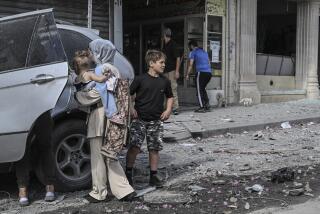Over Under, Sideways Down : WE WRECKED THE PLACE: Contemplating an End to the Northern Irish Troubles.<i> By Jonathan Stevenson</i> .<i> The Free Press: 294 pp., $25</i>
- Share via
One of the reasons it is so hard to bring peace to Northern Ireland is that the conflict has seldom been quite bad enough to be utterly intolerable. After the first few years of carnage, it settled down into what British politician Reginald Maudling rather tactlessly called “an acceptable level of violence.” Between 1976 and 1994, when an uneasy truce came into force, the murder rate remained at a level--an average of 86 deaths a year--that would have been a triumph for a police chief in any major U.S. city.
There were times--the Republican hunger strikes of 1981, the IRA’s massacre of Protestants at Enniskillen in 1987, the Shankill Road and Loughinisland massacres of 1994--when it seemed that things could not go on, that there had to be either all-out war or all-out peace. And then it would all sink back again into the familiar slow obscenity, horrible enough to drive decent people into despair but not horrible enough to force them into action.
This kind of conflict induces fatalism and intellectual numbness. The violence comes to seem as relentless as the rain in winter. The question “Why?” becomes pointless. The killing goes on because it goes on, one atrocity engendering the next, each side--the IRA, the Loyalist paramilitaries, the British security forces--justifying the pain it inflicts by the pain it has suffered.
Only in the 18 months of peace between the start of the IRA cease-fire in September 1994 and its bitter end with the murder of two bystanders in London in February 1996 was there a real opportunity to ask why a relatively minor conflict had continued for 25 years at a cost of more than 3,200 lives.
Jonathan Stevenson, an American journalist living in Belfast for the last three years, took that opportunity. The result is an exemplary piece of journalism, objective and angry in equal measure, often brilliant and always enlightening. It is one of the best half dozen books to have been written about Northern Ireland. Stevenson’s book is a kind of oral history of the Troubles.
At its heart is a series of interviews with people who have been members of the IRA or of Loyalist paramilitary organizations, most of them former prisoners. Placing such reliance on the testimony of people who are saturated in a culture of self-justification, propaganda and moral evasion is a risky business. A journalist who wants to do it needs an exceptional sense of balance--enough scepticism to see through the self-serving myths but enough human sympathy to be able to listen carefully to what it is being said. Stevenson never patronizes his interviewees or abuses their trust. But neither is he dazzled by the glamour of violence.
Much of what he learns contradicts the stereotype of the Irish as a people who cannot forget. If anything, the problem with some of his subjects is that they cannot remember. Donncha O’Hara, now a Sinn Fein press officer, formerly a member of the IRA, does not even know the name of the person killed by a bomb he planted on a Belfast street, recalling only that it was “some woman.” William “Plum” Smith, now a prominent member of the Progressive Unionist Party and formerly a member of the Loyalist paramilitary Red Hand Commando, “hasn’t a clue” whether the Catholic man he and his accomplice shot 14 times in 1972 is still alive.
What makes this book so much more than an account of a sordid squabble in a small country, though, is the way Stevenson captures the distorted logic of all conflicts, the way violence turns normality inside out. One former Loyalist paramilitary tells him that he enjoyed being in prison because “it was a far less violent place than it is out in this world.”
In a deadly paradox, the very pointlessness makes it hard for the paramilitaries--particularly the IRA--to stop the killing. Making peace now means settling in 1996 for what was on offer at least 20 years before, tacitly acknowledging that all the deaths suffered and inflicted in the meantime were meaningless. And it means being prepared to live with human confusions rather than to kill for certainties.
Stevenson is soberly optimistic about the prospects for a peace settlement, while recognizing that it will be a messy and protracted business. He is probably right.
The paramilitaries on both sides have not, as this book shows, undergone any kind of moral conversion. Most of them would kill again--if they thought it would get them anywhere. But they know that no amount of mayhem could get them anywhere worth going. The only future would be like the past, and we have, in this tough-minded, fiercely perceptive book, a trustworthy map of that grim and wasteful country.


